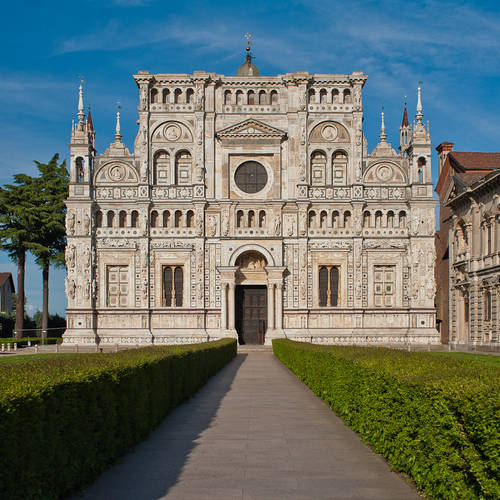Pavia
Pavia is a gorgeous town at the backside of Milan. Its layout still shows the legacy with the ‘roman castrum’. It was capital of the Longobard Reign, and experienced a golden age during the Medieval Era and the Renaissance under the dynasties of Visconti and Sforza. Well known for its university, which is one of the oldest in Italy, Pavia hosted the capture of Francesco I by Carlo V in 1525. There Francesco I put an end to his ambitions, loosing everything but “his honour” (Francesco I).

Pavia – CC BY-SA 2.0 | Giancarlo Scola | 2013
Departure is planned at 8 in the morning, and the bus will be waiting at the cross between Paleocapa Street and Jacini Street.
The first visit is to the Cripta di Sant’Eusebio, the Ariana cathedral dating back to the time of king Rotari, which, after the last Arian bishop Anastasio converted to Catholicism, was named Sant’Eusebio. Sant’Eusebio was the bishop of Vercelli town, and the persecutor of Arianism. The building underwent radical changes during the first half of the 11th century, when the chapel-crypt with its unique capitals was realized: the capitals are decorated by lanceolate triangles and leaves, excavated, definitely far from the classic tradition and rather close to the alveolate Longboard goldworking.
Visit to Chiesa di San Michele, a church of Longboard origin, where in High Medieval Era kings and emperors, such as Barbarossa, were crowned. It was rebuilt around the half of the 12th century, and stands as one of the masterpieces of Romanesque architecture in Italy. The shad looking façade is in sandstone, and shows precious decorations with animal and plants as a theme. The inside is impressive, and consists of three naves with matronei above the small naves. It preserves the istoriato style and illustrated capitals, the Crocefisso di Teodote in silver lamina dating back to the 10th century, and, in the presbytery a Romanesque mosaic showing the months.
The Duomo has one of the biggest domes in Italy, which dominates the city and represents one of the most meaningful creations of the Longobard Renaissance. It was built due to the will of the cardinal Ascanio Sforza in 1488, based on the project by Cristoforo Rocchi, Giovanni Antonio Amadeo and Dolcebuono. To its realization, which lasted for almost all the 16th century, took part Bramante, Leonardo and Francesco di Giorgio.

Duomo – Public Domain Mark 1.0 | Alessia Radaelli | 2016
Lunch is individual.
The Chiesa di Sant’Agostino is very famous in Pavia and was founded by the Longobards, while its current forms date back to the Romanesque period. It was sanctified in 1132, and above the main altar is preserved the gothic Arca di S. Agostino, whose bones were moved here in the 8th century following the will of the Longboard king Liutprando. In the crypt are preserved the vestiges of Severino Boezio, a roman philosopher who was the advisor of king Teodorico, and sent to death under accuse of betrayal by the king himself.
Visit to the Castello Visconteo, typical example of Renaissance architecture characterised by a square map with angular fortified towers, a charming inside court, which was built in 1360 under Galeazzo II Visconti. He wanted a grandiose park for hunting, which originally extended for ten kilometres, stretching all the way to the Certosa di Pavia. The building hosts the Musei Civici.
Visit to the precious Pinacoteca Malaspina, which preserves up to 250 paintings dating back to the period comprised between the 13th and the 17th century. Among the pieces of the collection, some masterpieces like the Cristo porta croce by Bergognone, the Ritratto d’uomo by Antonello da Messina, the Pala Bottigella by Vincenzo Foppa, and the Madonna col Bambino by Giovanni Bellini.

Certosa – CC BY 2.0 | mat’s eye | 2012
We move on to the Certosa di Pavia, to admire the notorious Certosa, beautiful heritage of the Lombard Renaissance, founded in 1396 by Gian Galeazzo Visconti as a family mausoleum. The façade, with a sober and elegant style, shows a unique variety of sculptures done by the Mantegazza brothers and by the Amadeo, and is a true masterpiece. Inside, beside the tomb of the founder, are kept illustrious art works, among which the canvases and frescos by Bergognone. We will also visit also the charming small cloister and the big one with the monks’ cells.
The arrival to Milan is planned by 7,30 PM.